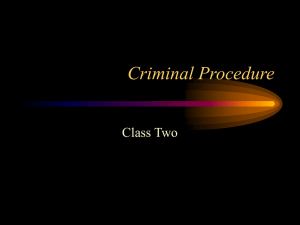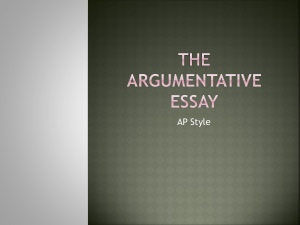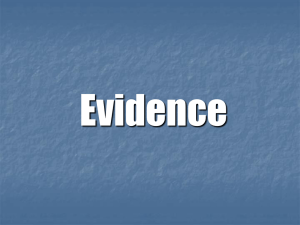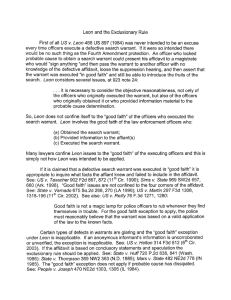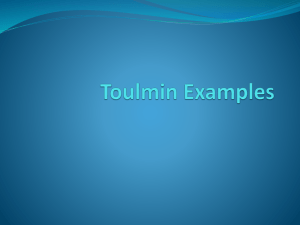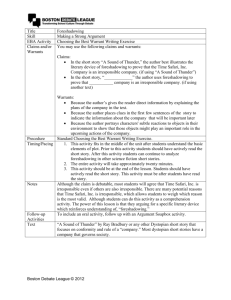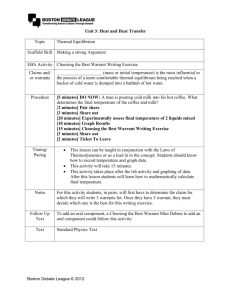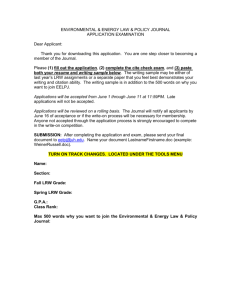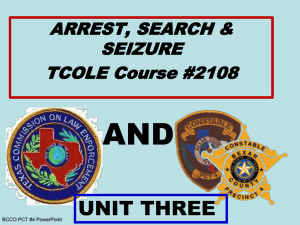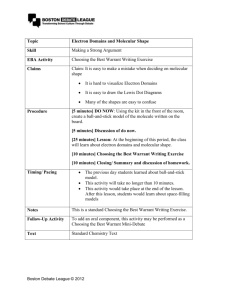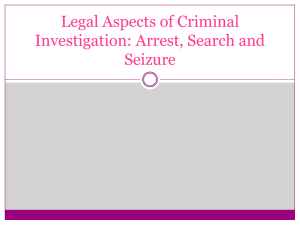O.P.O.T.A. BASIC TRAINING UNIT 11/TOPIC 16 - LEO
advertisement
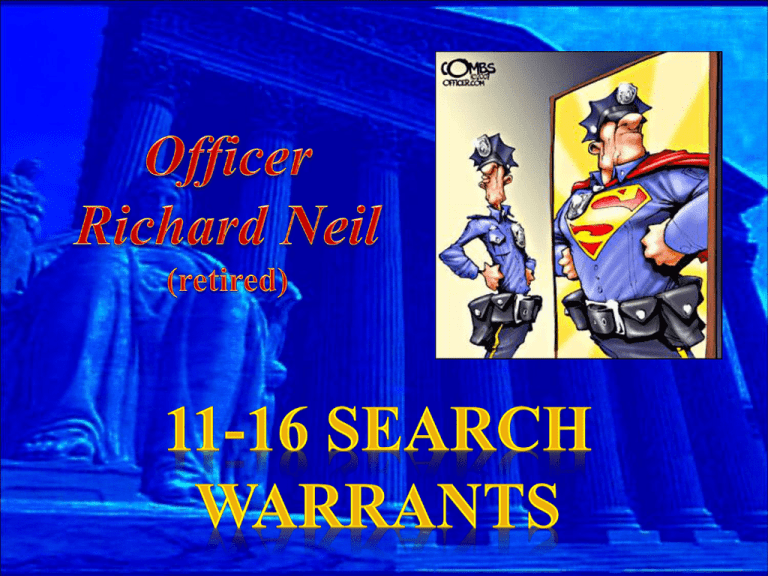
PURPOSE OF THIS SECTION HISTORY OF SEARCH WARRANTS BASIC REQUIREMENTS FOR WRITING AND OBTAINING A SEARCH WARRANT IN OHIO SEARCH WARRANTS During the colonial period in America, British officials were permitted to conduct random and unlimited searches. The unlimited and oftentimes, unwarranted, intrusions became one of the causes of the American revolution. When the framers of the U.S. Constitution gathered to write that historic document, the Fourth Amendment was written to ensure the right of Americans to be free from unreasonable searches and seizures. 4TH AMENDMENT ORIGINATING SOURCE FOR ALL LAWS RELATING TO SEARCH AND SEIZURE “RIGHT OF THE PEOPLE TO BE SECURE IN THEIR PERSONS, PLACES AND THINGS” OHIO STATE CONSTITUTION The right of the people to be secure in their persons, houses, papers, and possessions, against unreasonable searches and seizures shall not be violated; and no warrant shall issue, but upon probable cause, supported by oath or affirmation, particularly describing the place to be searched and the person and things to be seized. This language is almost verbatim to the language of the Fourth Amendment to the U.S. Constitution. SEARCH WARRANTS CAN BE ISSUED FOR - ORC 2933.21 STOLEN PROPERTY WEAPONS DRUGS FORGED OR COUNTERFEIT ITEMS OBSCENE MATERIALS (MAPP V. OHIO) GAMBLING DEVICES ILLEGAL LIQUOR HAZ/MAT ETC CRITERIA BEFORE SEARCH WARRANTS ARE ISSUED, MUST HAVE PROBABLE CAUSE. MORE THAN MERE SUSPICION/LESS THAN PROOF BEYOND A REASONABLE DOUBT SEARCH WARRANT MUST INCLUDE/DESCRIBE PLACE TO BE SEARCHED PERSONS TO BE SEARCHED PROPERTY TO BE SEARCH FOR OFFENSE IN RELATION TO PROPERTY PROBABLE CAUSE WHY AFFIANT BELIEVES PROPERTY WILL BE THERE ANY OTHER FACTS RELIVANT AFFIDAVIT DEFINED WRITTEN OR PRINTED STATEMENT OF FACTS, MADE VOLUNTARILY, AND CONFIRMED BY OATH OR AFFIRMATION OF THE PARTY MAKING IT, TAKEN BY A PERSON HAVING THE AUTHORITY TO ADMINISTER SUCH OATH OR AFFIRMATION SPO #3-AFFIANT DEFINED THE PERSON WHO MAKES OR SUBSCRIBES THE AFFIDAVIT OHIO LAW DEFINES DAYTIME AS THE HOURS BETWEEN 7:00 AM AND 8:00 PM. SEE CRIM.R. 41 (F) THE WARRANT MUST BE RETURNED TO THE ISSUING JUDGE OR MAGISTRATE NO LATER THAN THREE DAYS AFTER ITS ISSUANCE (NOT INCLUDING SATURDAY, SUNDAY, OR LEGAL HOLIDAYS). STATUTORY RECONDITIONS or NON-CONSENSUAL ENTRY MUST GIVE NOTICE OF PURPOSE BEFORE ENTRY MAY BE MADE If a nighttime search is requested, officers must indicate some type of urgent necessity, such as 1. The Criminal activity is being conducted during nighttime; 2. Protection to officers conducting the search and seizure; 3. Prevention of the destruction of evidence; 4. Other types of emergency circumstances Richards v. Wisconsin, U.S. (1997) The U.S. Supreme Court overruled a blanket exception created by a lower court that permitted no-knock entries in all felony drug cases. The Court required lower courts to decide on a case-by-case basis whether the facts of the case justify a no-knock entry. Richards v. Wisconsin, U.S. (1997) The Court further held for officers to establish the need for a no-knock entry, they must “have a reasonable suspicion that knocking and announcing their presence, under the particular circumstances, would be dangerous or futile, or that it would inhibit the effective investigation of the crime by, for example, allowing the destruction of evidence.” SPO #5-BURDEN OF PROOF MUST BE SATISFIED BEFORE WARRANT WILL BE ISSUED IS PROBABLE CAUSE TO BELIEVE ITEMS WILL BE AT A CERTAIN LOCATION. MORE THAN MERE SUSPICION/LESS THAN PROOF BEYOND A REASONABLE DOUBT Probable cause is a set of facts and circumstances known to the affiant personally or supplied by an informant or witnesses which causes the affiant to believe that items sought can be seized by virtue of being connected with illegal activity and those items will be found in the place to be searched The finding of probable cause may be based upon hearsay in whole or in part, provided there is a substantial basis for believing the source of the hearsay to be credible Not every fact must be included in the warrant in order to establish probable cause, however, those facts that are included must lead the judge or magistrate to the conclusion that probable cause exists to believe the items to be seized are located in the area to be searched. The warrant must be supported by the affiant swearing or affirming the information contained in the warrant is true BEFORE LEAVING LOCATION MUST LEAVE COPY OF SEARCH WARRANT AND INVENTORY (NOT THE AFFIDAVIT) PROMPTLY RETURN THE AFFIDAVIT, THE WARRANT ITSELF, AND THE COMPLETED RETURN TO THE ISSUING JUDGE. THE EVIDENCE MUST BE AVAILABLE TO THE JUDGE IF REQUESTED. SEARCH WARRANT REQUEST SEARCH WARRANT REQUEST SEARCH WARRANTS CAN BE SEALED WITH THE APPROVAL OF A JUDGE ESPECIALLY WHEN PROTECTING CONFIDENTIAL INFORMANTS United States v. Grubbs 126 S. Ct. 1494 (2006) The defendant purchased contraband from a web site operated by an undercover officer. The government sought an anticipatory search warrant. The contingency of the search was based on probable cause that would exist if the parcel has been received by a person(s) and has been physically taken into the residence. Good search? United States v. Grubbs 126 S. Ct. 1494 (2006) The Supreme Court held that probable cause to sustain a search warrant need only be present at the time the search is conducted. They require the magistrate to determine (1) that it is now probable that (2) contraband, evidence of a crime, or a fugitive will be on the described premises (3) when the warrant is executed. Winston v. Lee 470 U.S. 753, 105 S. Ct. 1611 (1985) The defendant shot a victim during an armed robbery, receiving a gunshot wound in the exchange. Shortly after the officers took the victim to a hospital, police found the defendant several blocks away from the shooting. The officers took him to the hospital, where the victim identified him as the assailant. The government asked the court to order the defendant to undergo surgery to remove the bullet lodged under his collarbone. Winston v. Lee 470 U.S. 753, 105 S. Ct. 1611 (1985) It asserted that the bullet would provide evidence of the defendant‘s guilt or innocence. Expert testimony suggested that the surgery would only entail a minor incision and could be performed under local anesthesia. The court granted the motion. However, X-rays taken just before surgery was scheduled showed that the bullet was lodged much deeper than the surgeon had originally believed. Winston v. Lee 470 U.S. 753, 105 S. Ct. 1611 (1985) ISSUE: Whether courts can order surgery to remove evidence of a criminal act from a suspect‘s body? HELD: Yes. However, this is a serious intrusion into the suspect‘s reasonable expectation of privacy and must be used only in extreme circumstances. As the government had available substantial additional evidence that the defendant was the criminal, its need to obtain the bullet was diminished.
